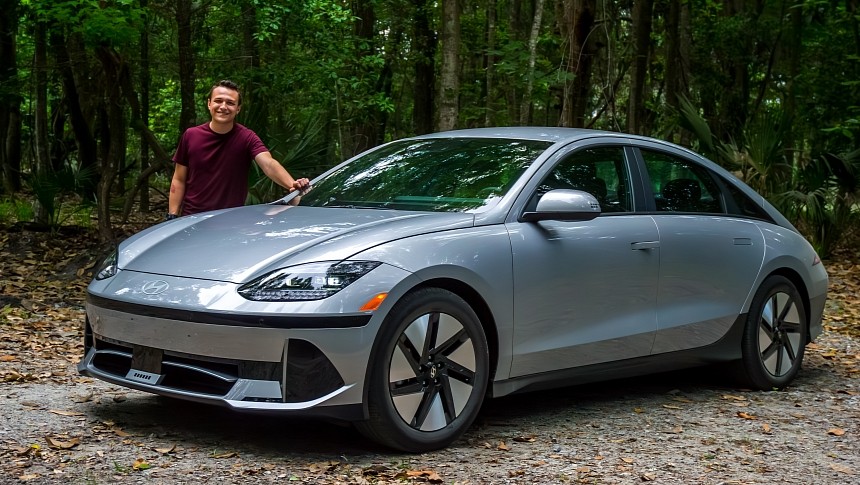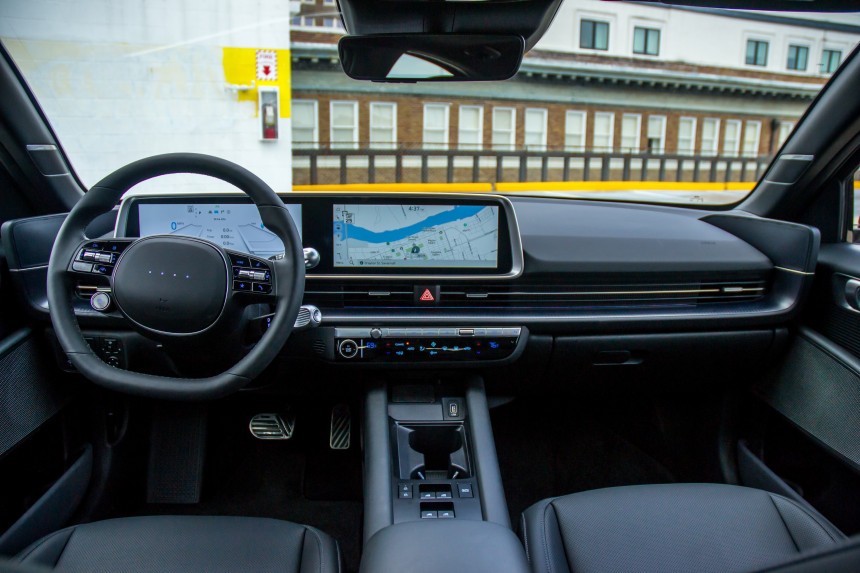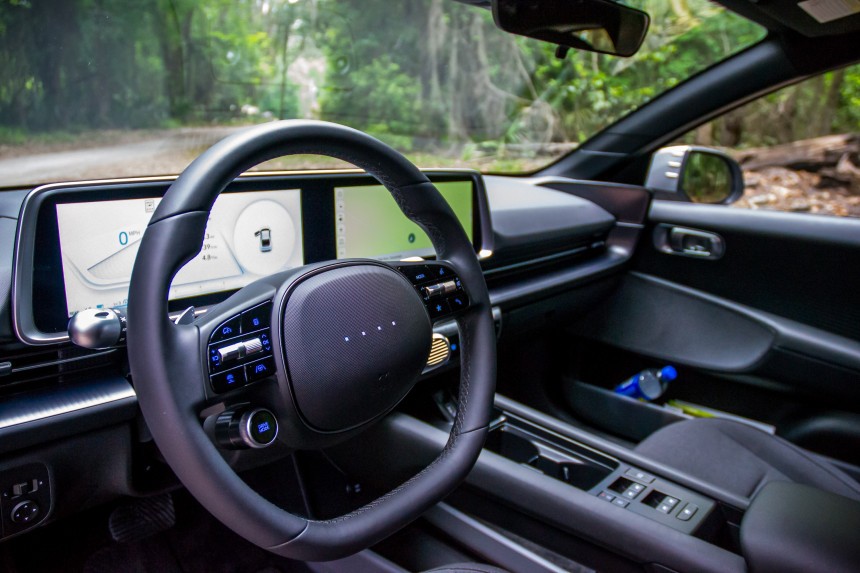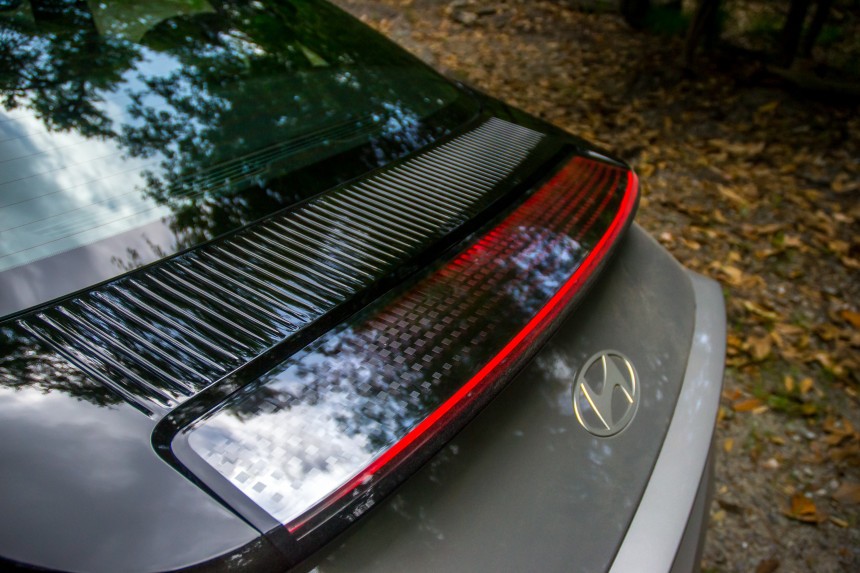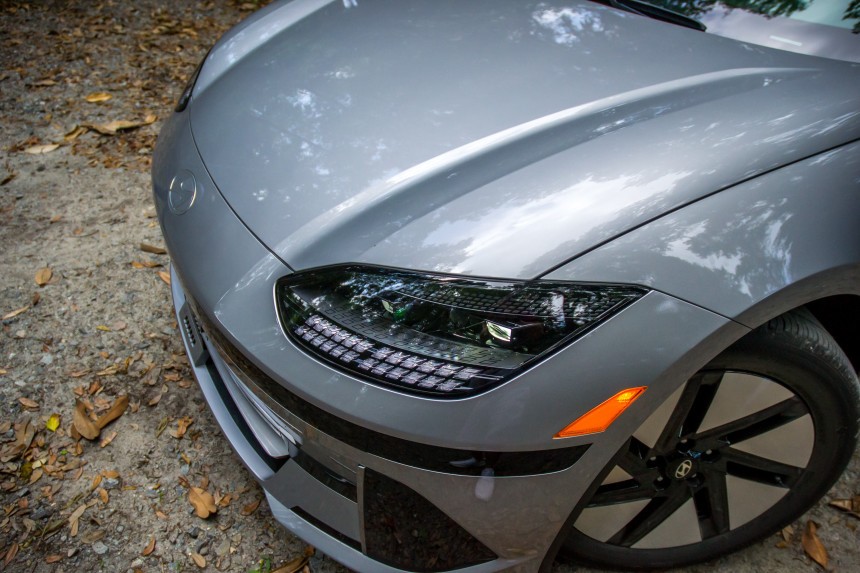You can’t convince me that the Hyundai Motor Company isn’t one of the most aesthetically impressive automakers in the space today. All of its recent models, from six-figure Genesis luxury barges, to middling EVs, to cheap $25,000 sedans, are visually interesting. That’s significant in a world where car brands have become more and more homogenous over the years. Every BMW, Porsche and Audi looks the same. I think Hyundai/Kia/Genesis’ EVs will age well as a result. But how they perform in the now is what matters most.
Because of that, I jumped at the chance to hop on a plane and sample Hyundai’s latest. “Hyundai like Sunday, not ‘hun-die!’” said the brand’s media representative just an hour after I had gotten off the plane. Pronunciation is important over there, I suppose.
Then again, attention to details such as those is what I think of when I envision new fully-electric products from the group. These three brands have become well-known for their forward-thinking design (and aesthetic) choices. I expected the same from the Ioniq 6. Still, it did have to do more than that, I reminded myself. This is a tough segment for what many folks still see as a bargain automaker. Also, both Tesla and Polestar both have fully-electric, two- or all-wheel drive sedans at this price point.
Tiny, square pixels aside, the Ioniq 6 is a swoopy thing. Frankly, I’ve already forgotten the “something-something Steamliner” marketing line from the car’s debut - which doesn’t matter because the vehicle truly impresses in person. This is what I was talking about earlier - Hyundai (Sunday) is very committed to making its cars look different - not unlike the design commitment made by its Nordic competitors.
While they get all blocky and minimalistic, Hyundai uses the teardrop shape to net a killer drag coefficient - perfect for boosting range, so long as you’ve got the right/wrong wheels. More on that later.
Starting up front, the car’s curvy theme is dragged all the way to the rear. It builds to a crescendo at the roof, and despite its near-immediate drop in height at the rear passenger cell, a few of our six-foot journalist friends on the media drive were able to fit in the back - important when your competition is built by tall Swedes. At the rear, I see a retro-futuristic 911. The little pixel lights play nicely with the whale-tail spoiler, and my only complaint is that it isn’t big enough, though perhaps Porsche would really have something to say if it got any larger.
Again, more on that later. For now, it’s best to discuss how these three trim levels change the feel of the interior. Three are offered: SE ($45,500 MSRP), SEL ($47,700), and Limited ($52,600). The SE is the only model in the range to get cloth seats. Frankly, the cloth doesn’t feel very premium, but it is very... recycled - a plus in the environmentally conscious segment. Move to SEL or Limited trims, and you’re getting the brand’s H-Tex Leather. This is, again, recycled plastic. Still feels nice, though.
To the layperson, spotting differences between trims here is tough. SEL and Limited models add wireless charging, the Hyundai Digital Key, and ambient lighting. Frankly, I think wireless charging/phone projection is a fad. The charging creates too much heat and won’t efficiently charge your phone like a cable will. Still, many see this as a luxury.
Despite this, the interior is just as well-designed and thought-out as the exterior. While Tesla is technically a competitor here, the Model 3 is so far behind in material quality and usability that Hyundai wins that one easily. Even if the climate controls aren’t physical ones. I understand that this is cheaper than making buttons fitting of a $50k-ish car, but I’d rather have cheap plastic buttons any day.
Contrast this interior with the Swedes, and in all honesty, it comes down to preference. I believe that the Polestar 2 has a much nicer interior, both in its use of materials and its design. But I cannot argue with the functionality the Ioniq 6 brings, especially having heard some gripes about the Swedes’ implementation of the Google-driven infotainment. Anyway, with this car, displays are clear and the touchscreen, while sometimes a little slow, is easy to use. The wheel controls are also easy - and use buttons rather than dumb haptic nonsense. Realistically, I had almost no notes when asked what I would improve on the Ioniq 6 by a brand representative.
I drove both the SE and Limited trims - rear and all-wheel drive respectively. The two probably wouldn’t feel that different to the majority of buyers. As with most cars, you only really feel the rear - or all-wheel drive when you push the car hard. No one will though, because regretably there isn't an Ioniq 6 N just yet.
So, how are these on the highway? Well, they’re slippery. The 6 is the slickest car Hyundai have ever made. Range doesn’t begin to noticeably fall until you start to worry about points on your driver’s license. Most importantly, the ultra-quiet electric drivetrain doesn’t give away any squeaks or rattles. These cars feel very solidly built. They’re also very comfy to ride around in. Even the base car has adjustable lumbar support, and I found all trims to be very comfortable.
Of course, the Georgia heat did make me wish for the Limited trim’s ventilated seats while cruising down the endless two-way roads outside Savannah. Speaking of cruising, we did quite a lot of it with the car’s ADAS enabled. Advanced Driver Assistance Systems, for the laypeople. The system works well, but it certainly is not as polished as, say, Ford’s or Tesla’s. We also noticed a quirk while tooling around a Savannah suburb - the proximity sensors were "detecting" ghosts, beeping at us while we sat at a light. It happened a few times, then never again.
Honestly, the bottom line here is that the majority of people will think this EV drives just like every other car riding on the brand’s shared E-GMP platform. In that sense, you’re driving the EV6, Ioniq 5, and Ioniq 6 regardless of which model you actually choose. This isn’t so much a critique as a realization. Brands have to find more ways to differentiate the driving experience - and not just with flashy lights, different (fake) sounds for the motors, or yet more heavy and expensive tech features.
Now, that said, the best way to eek range out of the Ioniq 6 is to mind your wheel choice. The AWD, Limited model I drove had an EPA-estimated range of 270 miles on the window sticker. The rear-drive, base model in contrast, read an estimated 361 miles on the sticker. The reason? Two more electric motors, yes, but primarily - and this is right from Hyundai, those 20-inch wheels. That is more than 100 miles gone so you can flex with some shiny wheels.
Yes, yes, they look neat and they’re a nice aesthetic break from the aerodisk style all EVs have. But you need that small, aerodynamic wheel in order to extract all 361 miles of range this car is capable of. So, if you need range, get the base car, save a few grand, and live life without fake leather and ventilated seats. I would. Heck, you can even get a RWD SEL model, get most of the Limited’s luxury items, and still manage an estimated 305 miles on a single charge.
Putting range aside, the Ioniq 6 is laughably easy to live with. Supposing you can find a charger that’ll match this absurd capability, its 800-volt architecture means you can charge from 10-80% in just 15 or so minutes. Most folks won’t ever need that, but knowing the car isn’t a bottleneck for charging speed is a huge relief.
You can also make your '6' more comfortable before you get in thanks to Hyundai’s app, on higher trims. You can pre-condition the battery before charging (which the car can also do if you tell the nav to head for a charger), and you can set the climate control.
Now, this is a sedan. Most folks prefer crossovers. But this car’s competitors also happen to be sedans (arguments can be made about the high-riding Polestar 2). Really, you’ll be able to fit yourself, the kids, gear, and just about anything that isn’t furniture in this car without issue. The trunk is roomy enough, the ride more than plush, and the day-to-day usability near perfect. Plus, if you like how these cars feel but need an SUV, you can just go grab an equally quirky and fun Ioniq 5 for about the same money. This is one of the benefits of the platform-sharing I was harping on earlier.
But if you ask me - and Hyundai - these are different buyers. The 6 stands alone right now, at least if you absolutely won’t consider anything with a rear hatch. Good for Hyundai-Sunday. The brand saw a gap to make something interesting in a small-ish segment, made it aesthetically unique (even among its peers) and brought it to market quickly. I have no doubt the 6 is going to sell to its millennial buyers looking for seamless integration of their technology (Hyundai’s words, not mine). It is, after all, a very good EV. Now, if Hyundai could bring some physical controls and a more unique driving experience into the mix, I’d buy one.
Then again, attention to details such as those is what I think of when I envision new fully-electric products from the group. These three brands have become well-known for their forward-thinking design (and aesthetic) choices. I expected the same from the Ioniq 6. Still, it did have to do more than that, I reminded myself. This is a tough segment for what many folks still see as a bargain automaker. Also, both Tesla and Polestar both have fully-electric, two- or all-wheel drive sedans at this price point.
Design Evaluation
Let’s stick with how the Hyundai-like-Sunday Ioniq 6 looks for a moment. The car received a lot of praise when its design debuted some months back, and I’m pleased to say it really holds up in person. As a quick side note, Hyundai-like-Sunday calls the pixels littered throughout the car’s design “parametric pixels.” We were told that over 600 of these little squares are in use throughout. You’ll find them in the lighting, seatback patterns, and on the car’s active air dams below the nose.While they get all blocky and minimalistic, Hyundai uses the teardrop shape to net a killer drag coefficient - perfect for boosting range, so long as you’ve got the right/wrong wheels. More on that later.
Starting up front, the car’s curvy theme is dragged all the way to the rear. It builds to a crescendo at the roof, and despite its near-immediate drop in height at the rear passenger cell, a few of our six-foot journalist friends on the media drive were able to fit in the back - important when your competition is built by tall Swedes. At the rear, I see a retro-futuristic 911. The little pixel lights play nicely with the whale-tail spoiler, and my only complaint is that it isn’t big enough, though perhaps Porsche would really have something to say if it got any larger.
Interior Assessment
I want to say a quick 'thank you' before going further. Hyundai brought a base SE and a highly-optioned Limited car for the launch event - and to boot they made sure little ol’ me got some extra seat time to compare the two. This is very important, as I’m now able to tell you how to save money.To the layperson, spotting differences between trims here is tough. SEL and Limited models add wireless charging, the Hyundai Digital Key, and ambient lighting. Frankly, I think wireless charging/phone projection is a fad. The charging creates too much heat and won’t efficiently charge your phone like a cable will. Still, many see this as a luxury.
Despite this, the interior is just as well-designed and thought-out as the exterior. While Tesla is technically a competitor here, the Model 3 is so far behind in material quality and usability that Hyundai wins that one easily. Even if the climate controls aren’t physical ones. I understand that this is cheaper than making buttons fitting of a $50k-ish car, but I’d rather have cheap plastic buttons any day.
Contrast this interior with the Swedes, and in all honesty, it comes down to preference. I believe that the Polestar 2 has a much nicer interior, both in its use of materials and its design. But I cannot argue with the functionality the Ioniq 6 brings, especially having heard some gripes about the Swedes’ implementation of the Google-driven infotainment. Anyway, with this car, displays are clear and the touchscreen, while sometimes a little slow, is easy to use. The wheel controls are also easy - and use buttons rather than dumb haptic nonsense. Realistically, I had almost no notes when asked what I would improve on the Ioniq 6 by a brand representative.
Driving Take
Once I was done poking around the interior, it was time to set off. You may, like I so frequently did, hit the turn signal instead of the drive-selector stalk that sits just below it. Still, eventually the car will get moving.I drove both the SE and Limited trims - rear and all-wheel drive respectively. The two probably wouldn’t feel that different to the majority of buyers. As with most cars, you only really feel the rear - or all-wheel drive when you push the car hard. No one will though, because regretably there isn't an Ioniq 6 N just yet.
So, how are these on the highway? Well, they’re slippery. The 6 is the slickest car Hyundai have ever made. Range doesn’t begin to noticeably fall until you start to worry about points on your driver’s license. Most importantly, the ultra-quiet electric drivetrain doesn’t give away any squeaks or rattles. These cars feel very solidly built. They’re also very comfy to ride around in. Even the base car has adjustable lumbar support, and I found all trims to be very comfortable.
Of course, the Georgia heat did make me wish for the Limited trim’s ventilated seats while cruising down the endless two-way roads outside Savannah. Speaking of cruising, we did quite a lot of it with the car’s ADAS enabled. Advanced Driver Assistance Systems, for the laypeople. The system works well, but it certainly is not as polished as, say, Ford’s or Tesla’s. We also noticed a quirk while tooling around a Savannah suburb - the proximity sensors were "detecting" ghosts, beeping at us while we sat at a light. It happened a few times, then never again.
Everyday Living
This section feels like the best place to have the range discussion that accompanies every EV review. First and foremost, you probably don’t need 300 miles of range on the daily. It’s a nicety, and brands have picked up on this arbitrary figure over the years, so here we are.Now, that said, the best way to eek range out of the Ioniq 6 is to mind your wheel choice. The AWD, Limited model I drove had an EPA-estimated range of 270 miles on the window sticker. The rear-drive, base model in contrast, read an estimated 361 miles on the sticker. The reason? Two more electric motors, yes, but primarily - and this is right from Hyundai, those 20-inch wheels. That is more than 100 miles gone so you can flex with some shiny wheels.
Yes, yes, they look neat and they’re a nice aesthetic break from the aerodisk style all EVs have. But you need that small, aerodynamic wheel in order to extract all 361 miles of range this car is capable of. So, if you need range, get the base car, save a few grand, and live life without fake leather and ventilated seats. I would. Heck, you can even get a RWD SEL model, get most of the Limited’s luxury items, and still manage an estimated 305 miles on a single charge.
You can also make your '6' more comfortable before you get in thanks to Hyundai’s app, on higher trims. You can pre-condition the battery before charging (which the car can also do if you tell the nav to head for a charger), and you can set the climate control.
Now, this is a sedan. Most folks prefer crossovers. But this car’s competitors also happen to be sedans (arguments can be made about the high-riding Polestar 2). Really, you’ll be able to fit yourself, the kids, gear, and just about anything that isn’t furniture in this car without issue. The trunk is roomy enough, the ride more than plush, and the day-to-day usability near perfect. Plus, if you like how these cars feel but need an SUV, you can just go grab an equally quirky and fun Ioniq 5 for about the same money. This is one of the benefits of the platform-sharing I was harping on earlier.
Test Drive Roundup
All this leaves the Ioniq 6 right where it needs to be. Frankly, I wouldn’t touch a Model 3 with a 10-foot pole, especially given the man at the helm. This car blows Tesla out of the water. Polestar? Maybe a bit closer than either brand would like. Given its luxury leanings, you’d think the 270-mile, $51,900 Polestar 2 would be more expensive. You’d also expect the $57,425 Ioniq 6 Limited AWD to be cheaper.Pros
- 800v architecture
- Wholly unique and interesting design
- Killer range
- Tech
Cons
- Why do wheels eat so much range?
- Limited trim is more expensive than more luxurious competitors
- Why can’t we have physical climate controls in 2023?
- No range-saving 18-inch wheel option for higher trims
